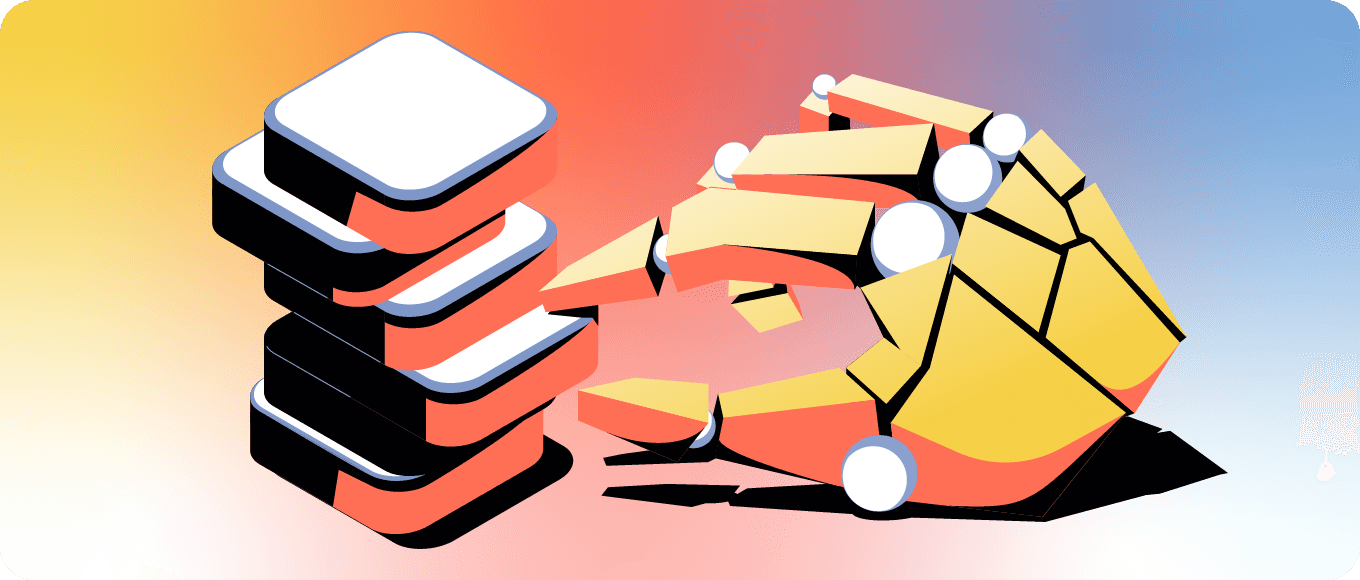There are many tools you can choose to power your marketing efforts. As marketers, we have more options than ever to build a marketing technology stack that’s aligned with our goals and needs.
That sounds like a good thing, but there’s a problem…
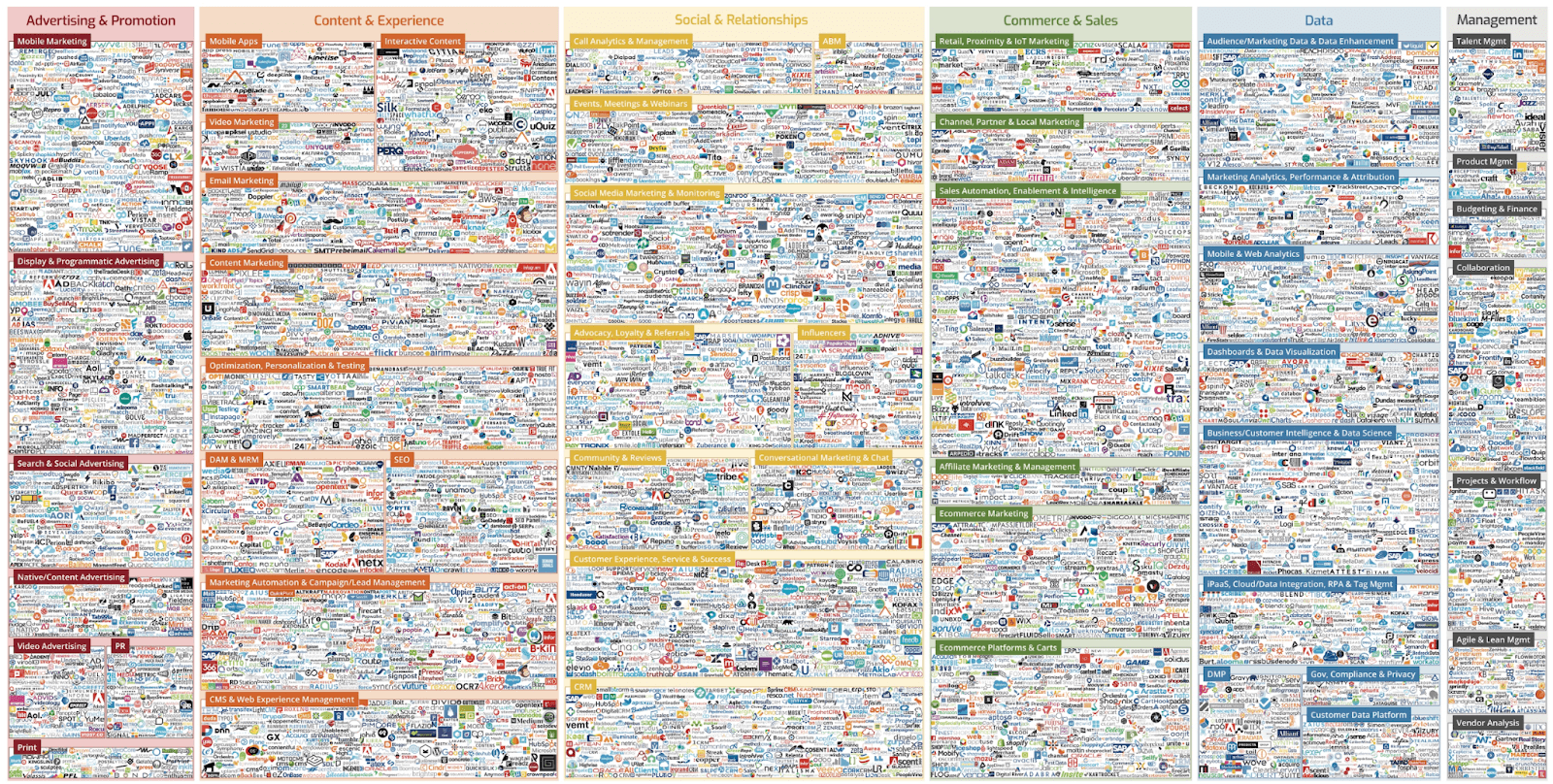
Source
There are so many of them it’s hard to know where to even start. What’s worth your effort and budget? What will genuinely allow you to create the results you want?
Luckily, there’s a way to build your martech stack and narrow more than 10,000 software options down to just a handful: being strategic about your marketing toolkit. This guide will show you how.
[table of contents]
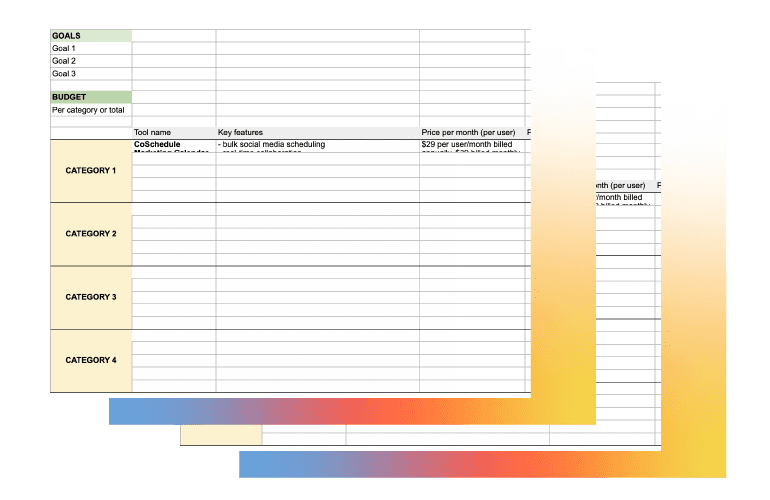
Get Your Marketing Stack Template
Plus, join our email list to stay up to date.
Success! Your download should start shortly. Or you can download it manually here.
What Is Marketing Technology (Martech)?
Martech
Marketing technology, also called martech, is the software marketers use to plan, optimize, and execute their marketing activities.
This software lets them build and promote content, interact with the company’s audience, generate press mentions, schedule posts across platforms, and analyze performance—all in the service of business goals like demand generation, lead generation, conversion, and customer retention.
What Is A Martech Stack?
Martech Stack
A martech stack is the combination of software tools you use to power your marketing efforts.
Your martech stack will cover a range of:
- Channels: blog, email marketing, social media, etc.
- Content formats: text, video, images, etc.
- Process steps: brainstorming, outlining, writing, recording, editing, publishing, updating, etc.
- Goals: audience growth, lead generation, sales, retention, analytics, etc.
The ideal marketing tech stack is the one in which you’ve picked your tools strategically and ensured they work well together—whether through native integrations or third-party tools like Zapier.
That way, you can work inside each tool intentionally to complete your marketing tasks for the day quickly, efficiently, and with maximum results.
The Types Of Martech Tools To Consider In Your Stack
Each company’s martech stack is like a fingerprint—no two marketing stacks are alike, just like no two marketing teams function the same way.
When considering different marketing platforms and tools for your team’s tech stack, remember that there will be some overlap between tools in different categories and that some tools may cover multiple categories. That’s okay. What matters is what a tool can do best for your marketing team’s needs at different stages of your processes, from core activities to small, repetitive tasks.
In other words, consider these categories a starting point, not a must-have. Let’s go over each of them:
1. Customer Relationship Management (CRM) Tools
A CRM tool will keep all of your prospect and customer data integrated and easy to access.
This way, you can track your lead generation, the activities that help turn a lead into a customer, and the steps to onboard new customers. Do this successfully, and you’ll turn them into your loyal users and brand ambassadors.
Examples of CRM tools: Salesforce, Pipedrive, HubSpot
2. Customer Support Tools
Customer support tools make it easy to monitor, assign, and solve any issues that come up for your customers. These tools can offer solutions like live chat, a knowledge base, email, phone, and more.
Examples of customer support tools: Intercom, Zendesk, Help Scout
3. Email Marketing Tools
With email marketing tools, you can send newsletters to your whole list or segment your list to send specific emails to customers based on what they purchased, the emails they previously opened and interacted with, their status in your loyalty program, and more.
Examples of email marketing tools: Mailchimp, Constant Contact, AWeber
4. Social Media Marketing Tools
You can use a social media marketing platform to create, schedule, and analyze your social media posts across different platforms, like Instagram, Twitter, Facebook, TikTok, and Pinterest.
Examples of social media marketing tools: Hootsuite, Buffer, Sprout Social
5. Marketing Project Management Tools
Marketing-focused project management software lets you plan and execute every step of your marketing campaigns from one central platform.
That means whether you’re planning a piece of content or a bigger launch, you can instantly integrate all moving pieces—like the creative stages and the social media promotion— from the start. This lets you stay organized, flexible, and on track.
Examples of marketing project management tools: CoSchedule’s Marketing Calendar and Marketing Suite
6. Social Listening & Brand Monitoring Tools
Social listening and monitoring tools let you grasp how people perceive your brand, products, competitors, and the industry as a whole. The insights you get from social listening and brand monitoring can be a foundation for customer loyalty efforts, creative marketing campaigns, and press activities.
Examples of social listening and brand monitoring tools: Brandwatch, BuzzSumo, TweetDeck
7. Landing Page Tools
With landing page tools, you can build a landing page or an embeddable opt-in form for any kind of marketing campaigns, like experiments with new types of lead magnets, email list building, product launches, and more.
Examples of landing page tools: Unbounce, Leadpages
8. Content Management System (CMS) Tools
Your CMS is where you upload, publish, and manage all of your website content. This includes blog posts, product pages, pricing, FAQ pages, case studies, and essential sections like ‘about us’ and contact forms.
Having clearly outlined ownership over various parts of a software solution is essential for all tools in your marketing tech stack, but this is even more emphasized in your CMS. That’s because any changes you make to specific sections, pages, or blog posts should be reflected elsewhere for a consistent customer journey and experience.
Examples of CMS tools: WordPress, Webflow
9. Analytics Tools
How is your marketing doing against your goals? That’s the question analytics tools answer.
This includes the size of your audience, the channels they use to find you and interact with your content, how long they stick around, how often they return, how many of them convert into subscribers or customers, and more.
Examples of analytics tools: Google Analytics, Hotjar, Mixpanel
10. SEO Tools
If search engine rankings are your priority, you’ll need SEO tools to research keywords, understand search intent, come up with and narrow down topic ideas, and track how your position in search results changes as you invest in your SEO.
Examples of SEO tools: Ahrefs, Semrush, Moz
11. Online Advertising Tools
Want to invest in paid ads on social media and/or search engines? For this, you’ll rely on martech tools that allow you to place your ads, track their performance, and even use machine learning to optimize your ad results.
This way, your ads will reach the right people at the right time, and you’ll make the most of your ad budget.
Examples of online ad tools: AdRoll, Criteo
12. Video Tools
If video is part of your marketing strategy, whether short-form video on social media or long-form video on your website or YouTube, video tools will help you record and edit your content.
Thanks to these tools, you can record your screen or make a voiceover, as well as import other clips and edit them into a final product that shares your message.
Examples of video tools: Screenflow, VEED, Biteable
13. Automation Tools
There are lots of things in marketing that can create next-level results but don’t need to be done manually.
Sending post-purchase emails, following up a few days after a customer support issue was solved, SMS campaigns that recommend products based on past purchases—you can do this, and so much more, thanks to automation tools.
Examples of automation tools: HubSpot, Klaviyo
14. Content Curation Tools
One of the biggest content challenges is always generating fresh, original ideas and creating content from it. Content curation lets you share third-party ideas your audience loves, finds relevant, and trusts you for—without adding more work to your plate.
Examples of content curation tools: Feedly, Scoop.it
15. Content Optimization Tools:
Want your long-form content to do well in search? Content optimization tools help you make it as relevant and comprehensive as possible and analyze search intent, your competitors, crucial terms to cover in your content, and more.
Examples of content optimization tools: CoSchedule’s Headline Analyzer and Headline Studio, Frase, Clearscope
16. Digital Asset Management Tools:
As you build different marketing campaigns, do you know exactly where to find each digital asset you need—an image, logo, video, and the latest version of a draft? What about others on your team?
A digital asset management tool is a crucial part of marketing management. It will help you store, index, and share each file you need so everyone can do their best work and save time looking for the assets they need.
Examples of digital asset management tools: CoSchedule’s Asset Organizer, Google Drive, Dropbox
Get Inspired: CoSchedule’s Marketing Tech Stack Diagram
Your martech stack diagram can look any way you want.
For example, you can focus on the stages of the marketing funnel—awareness, consideration, purchase, and retention—and split your tools that way.
Or you can divide your tools into stages of your process, like planning/brainstorming, execution, and analysis.
CoSchedule’s marketing stack diagram has parts of both approaches, representing how our workflow and marketing funnel work together:
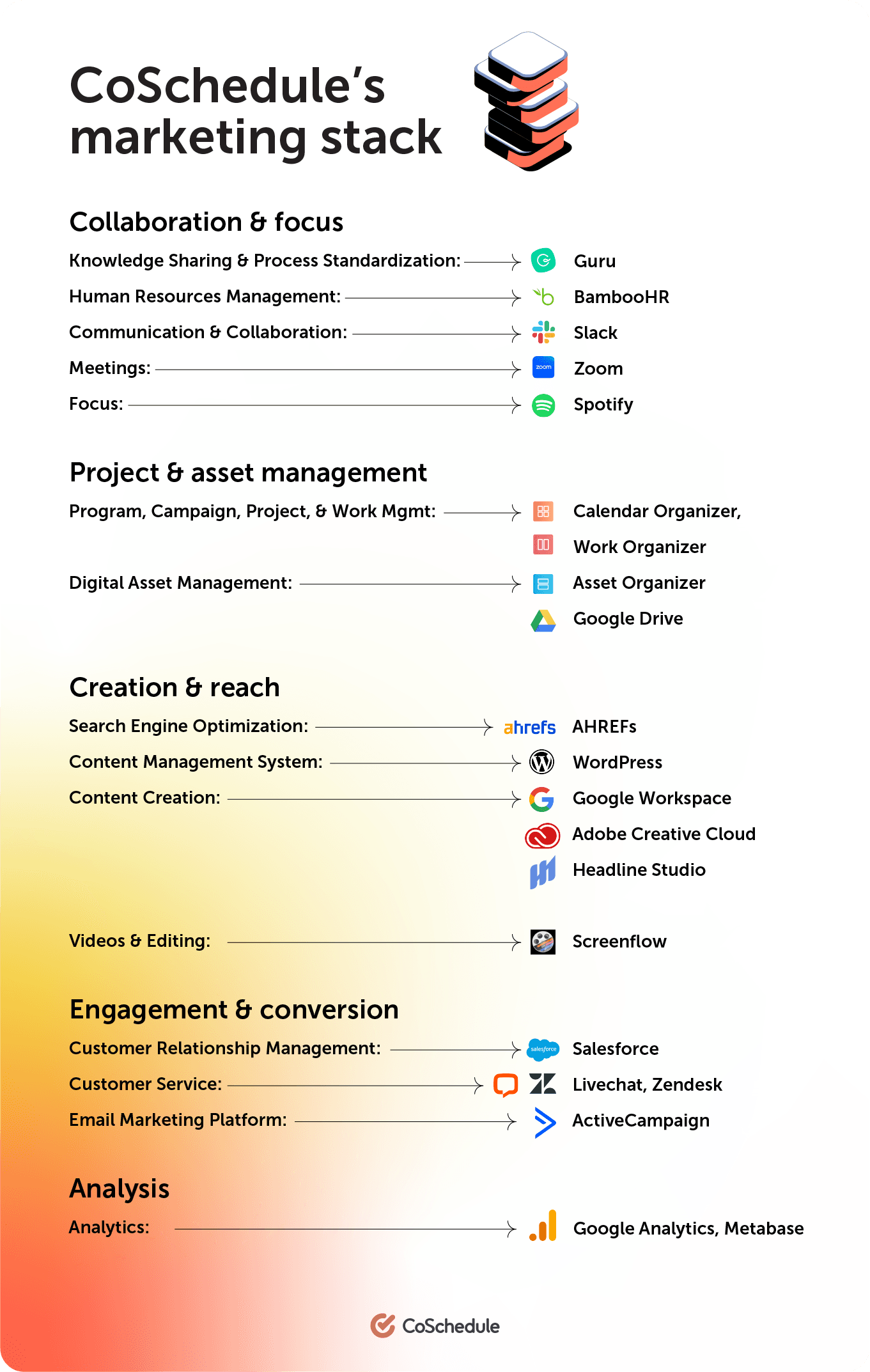
Check Out 5 Marketing Tech Stack Examples (With Diagrams)
If you want more ideas and inspiration for how to structure and visualize your tech stack, check out these martech stack diagrams from companies of different sizes and industries.
Brighttail, a B2B marketing agency, divided its martech stack into planning, execution, distribution, reporting, optimization, and alignment:
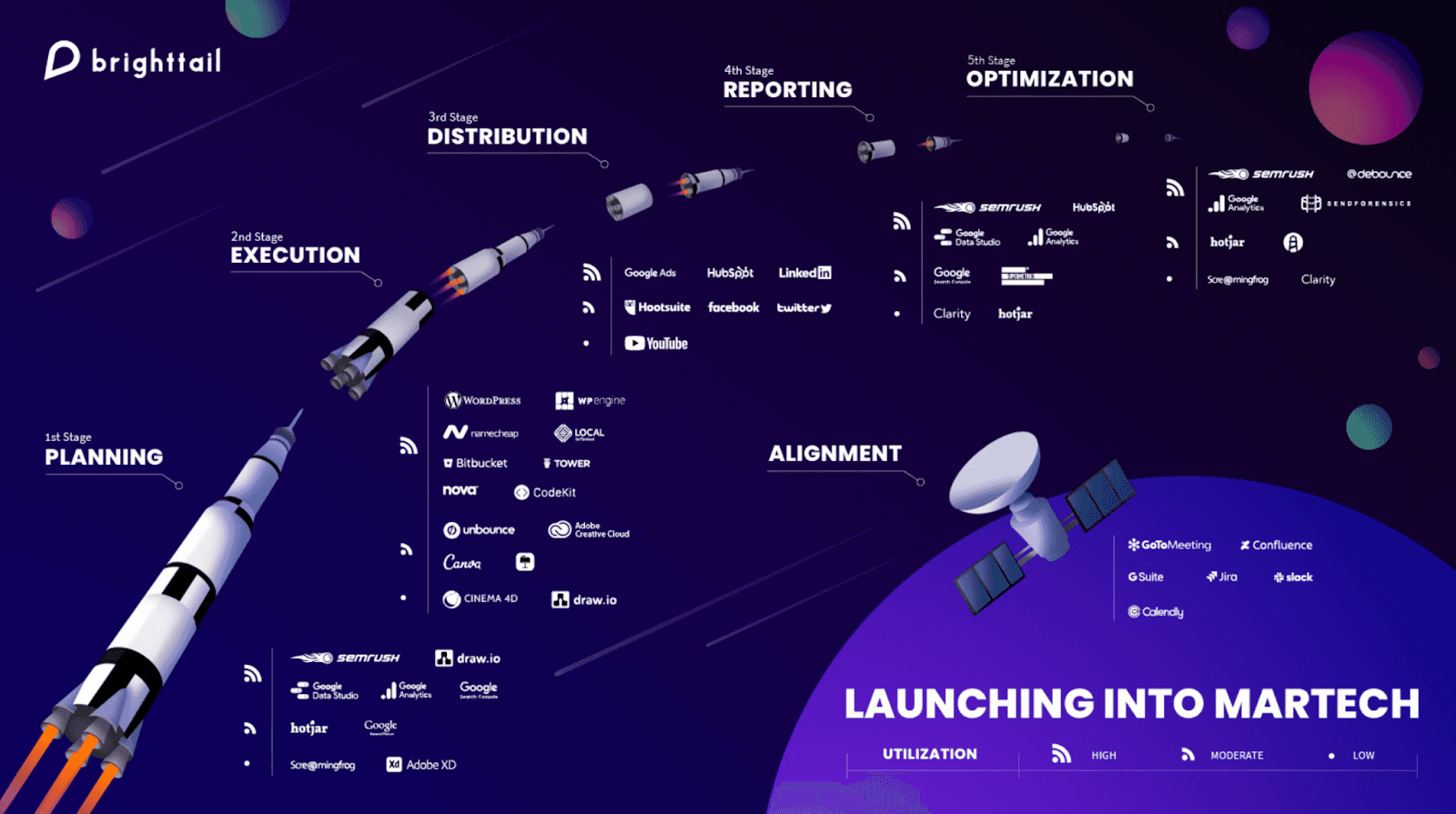
Source
UnitedHealthcare, an insurance company, split its marketing tech stack into marketing automation and engagement, analytics and reporting, digital publishing, asset management, and productivity tools:

Source
For Philips, the health tech giant, everything starts from the customer and branches out into website, mobile app, social, event, sales, and customer care:
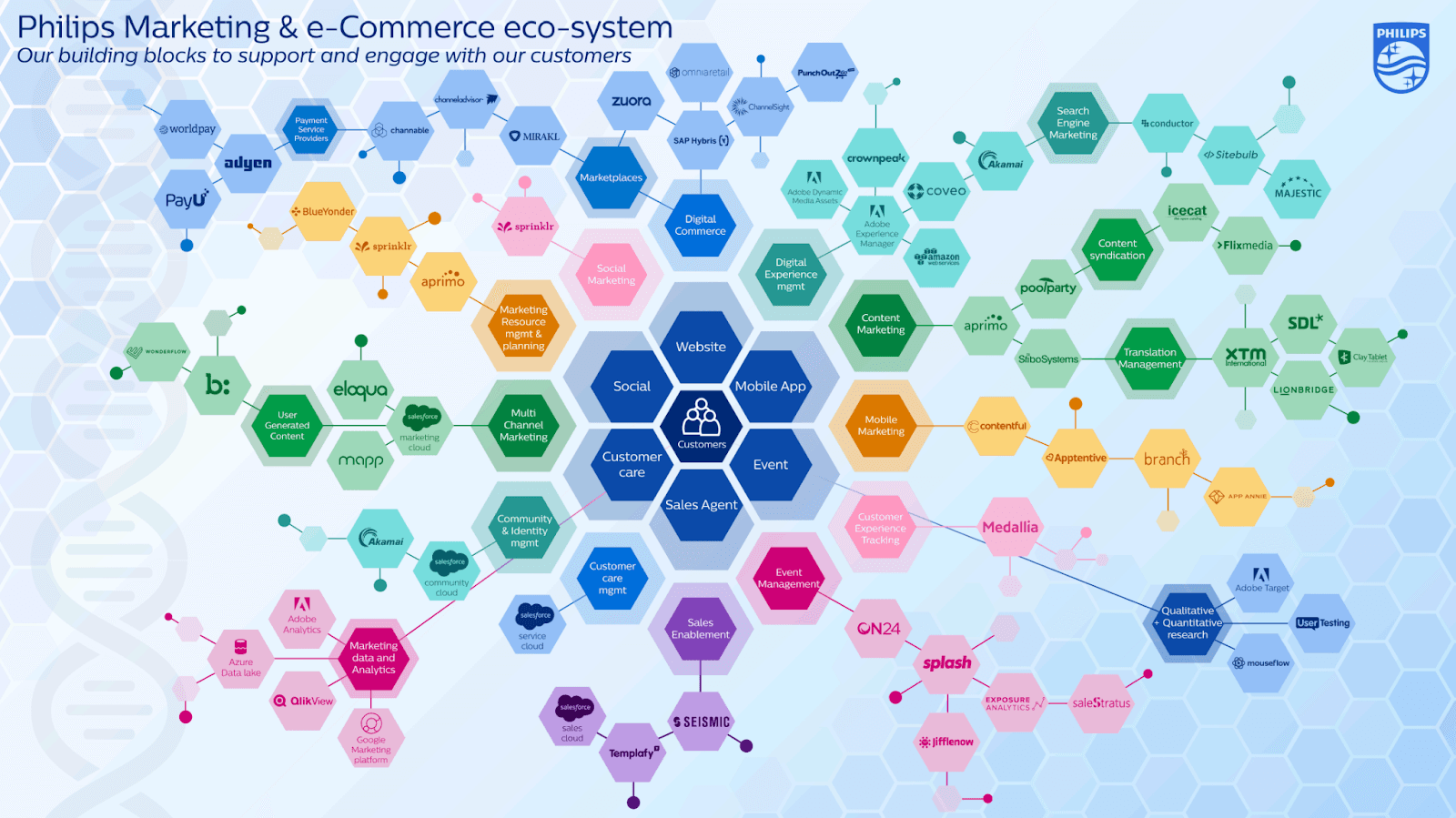
Source
Filestage, a review and approval platform, divided its marketing tech stack into the collaborate, create, grow, nurture, and future categories:
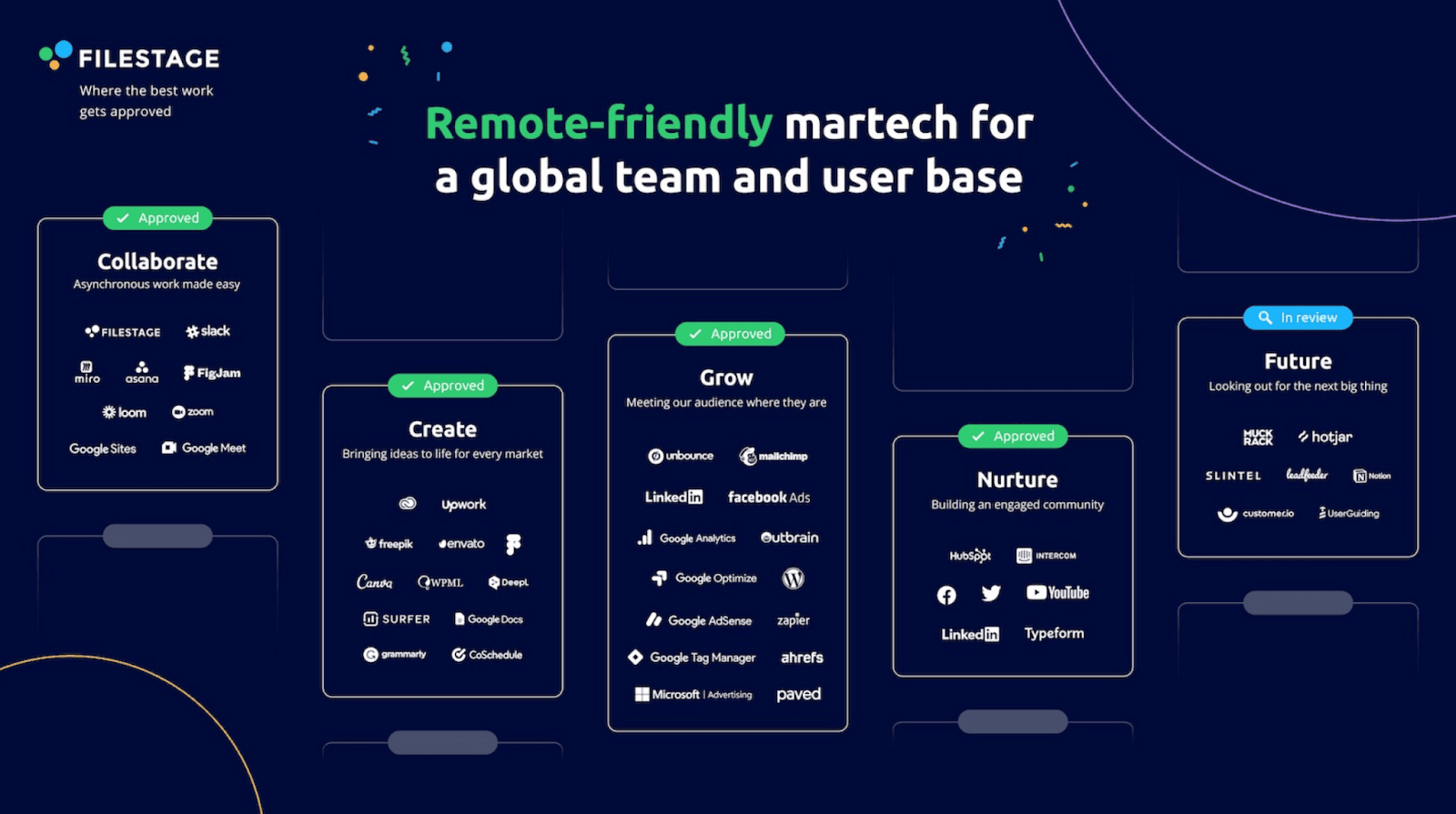
Source
Finally, for Rabobank, a financial services company, the martech stack is split into collect, unify, enrich, activate, create, and predict categories:
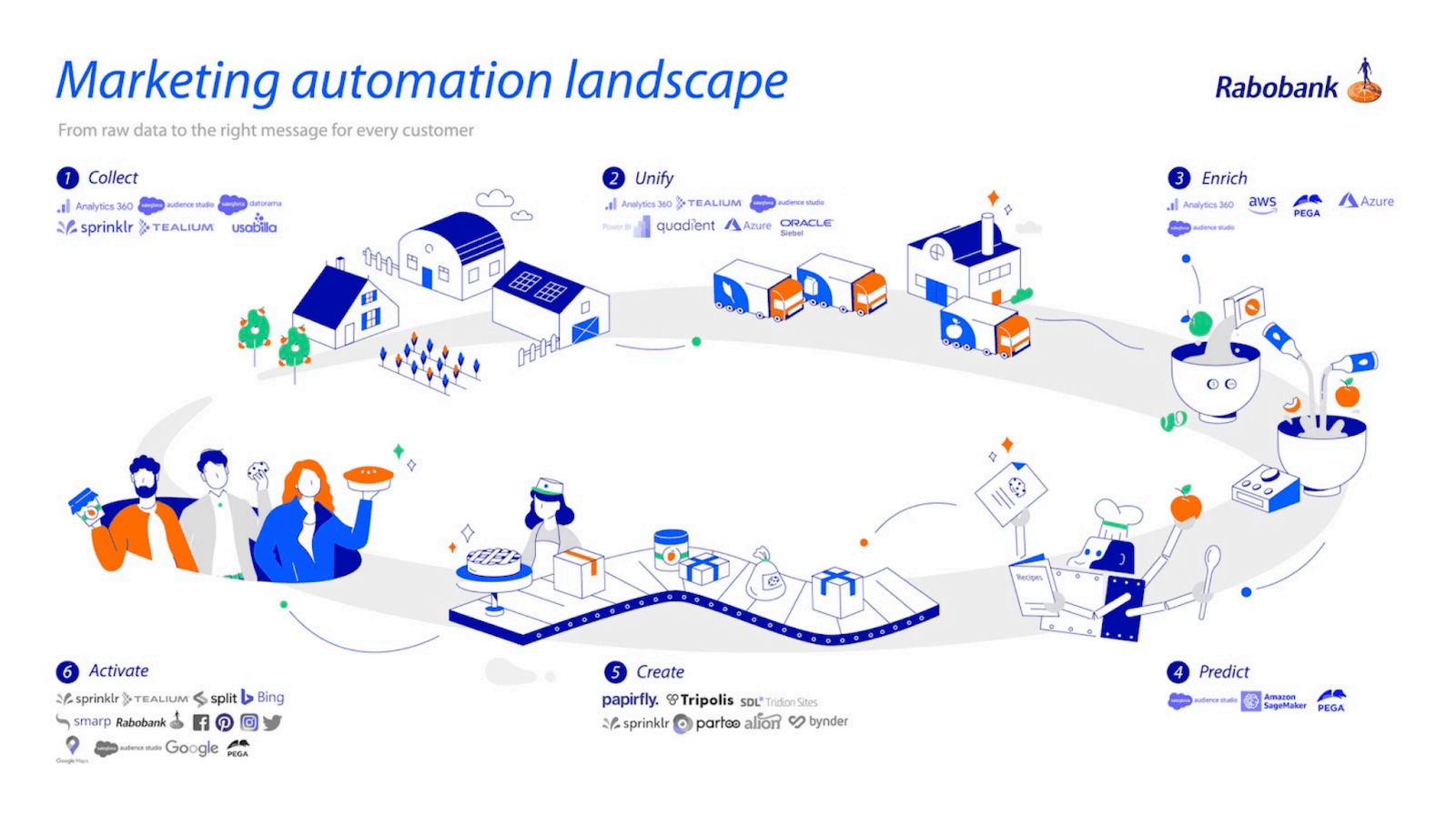
Source
How To Build Your Martech Stack
Building the right marketing tech stack requires some effort up front, but getting it right means you’ll reap the rewards for a long time to come.
It also means you won’t have to redo this process over and over, which would take precious budget, time, and energy away from marketing projects and the results they could create.
Remember: you can use our marketing stack template to track your research, share it with your team, and use it to make the most informed decision.
Here are the steps you can follow:
Step 1: Take Note Of Your Marketing Goals & Channels
You could argue that every company’s marketing goal is to be known in their industry and to win customers. After all, that’s the essence of marketing.
But in order to execute the right campaigns (and source the right tools for them), we need to get more specific. Here are two examples of SMART marketing goals:
- Higher search engine rankings: “By the end of the year, we will increase our search results page position from 12th to the top 3 for our main brand-related keywords to drive more organic traffic. This also leads to our pages through keyword and content optimization.”
- Lead generation: “We will bring in 100 new leads by the end of the year by carrying out targeted campaigns on social media involving a mix of paid and organic posts.”
In this first step, outline marketing goals you’re focusing on in the next few quarters, along with the channels you’ll use to hit those goals.
If you’re curious about new channels and experiments you could run, but it doesn’t fit into your goals for the year, take note of them—but don’t let them become a shiny object that distracts you from the goals that will drive your company forward.
Step 2: Get Input From Marketing Team Members
No matter how big or small your marketing team is, create a safe space for them to voice their needs for tools, platforms, templates, and resources they need to do their best work. Include managers, writers, editors, strategists, SEOs—everyone.
Ask them to privately brain-dump their thoughts and needs into a document, a structured survey, during a meeting, or some combination. Here are some questions you can use as prompts:
- What tools have helped you do your job the most?
- What tools or features are you currently missing?
- What tool or resource would make your workflow smoother or less challenging?
- Is there anything that takes longer than it could?
- What part of your workflow could you better automate or integrate with other tools?
You might get suggestions for tool features and functions they crave or specific tools on the market. Consider all suggestions valid, and take note of them all.
Step 3: Define Your Budget Range
Some tools are free or cost $15 per month, while others come up to four-figure price tags per year. Neither are inherently good or bad options—what matters is how they fit into what you need and what you can afford.
Before you start researching different tools and options, it’s hard to know the exact budget you’ll need for them. Still, try to come up with a realistic budget range for your marketing tools every year—this will make your research more guided.
Step 4: Dive Into Research For Potential Tools In Your Marketing Stack
Start by listing potential tools from what your team members mentioned in their responses and similar/competitive tools to those.
To get more tool ideas, tap into websites like G2 and Capterra, as they let you navigate different tool categories. You can also check out YouTube videos, tweets, and LinkedIn posts that mention personal experiences and tool recommendations.
Then, dive into:
- Reviews on above mentioned (and other) review sites from companies similar to yours in size, industry, etc.
- Case studies and success stories to understand if your challenges and pain points match those that successful customers experienced before using the tool
- Pricing options, including different plans, billing cycles, and cost per seat
- How long it takes to get started and to fully use the tool
The priority here is to make sure a tool fits your needs before you even get to the pricing details. Pricing is what helps match specific tools to your budget.
Step 5: Select Your Tools & Run Them By Your Team
It’s time to select your tools. You now have a couple of options per tool category (ideally not many more than that) along with their costs.
Run through each category and choose one tool based on the ratio of its benefits and price—if a tool is slightly more expensive than others, but brings dramatically more benefits based on your needs, it’s probably your best bet.
Once you have a list of your preferred tools, get your team together again and gather their feedback. You’ve already used their inputs for your research and selection, so this should ensure everyone’s in the same place—and happy—about the stack you picked.
Step 6: Make Your Purchases, Get Onboarded, & Review Regularly
Finally, sign up for your chosen tools. If the company offers onboarding, take advantage of it along with any teammates that will be using it so you can make the most of the features the tool provides.
Schedule a recurring reminder—for example, every six to 12 weeks—to review how your stack is serving you in your pursuit of ambitious marketing goals. Success lies in this regular effort to make the most out of the tools in your toolbox, so you can sharpen, tweak, or replace them if necessary.
Build Your Martech Stack Into Your Workflow
The tools you pick are the gear that helps you execute powerful activities that bring results. The activities in question, of course, are down to what’s in your marketing strategy—and your marketing calendar.
So make sure they’re the right ones.
Martech Stack FAQs
What Is An Example Of Marketing Technology?
Marketing technology includes tools and platforms that help marketers deliver their best work and hit marketing and business goals.
This can be a CRM platform, a marketing calendar tool, a social media scheduler, and a blog post optimization tool.
What Are Marketing Tech Tools?
Marketing tech tools help marketers execute every stage of a marketing campaign— from planning and outlining campaigns to building content, launching campaigns, analyzing marketing data, and automating/streamlining a marketing process.
How Do You Build A Marketing Tech Stack?
Building a marketing tech stack includes these six steps:
- Take note of your marketing goals and channels
- Get input from all marketing team members
- Define your martech stack budget range
- Research potential tools for your stack
- Select your tools and run the list by your team
- Purchase marketing tools, go through onboarding, and review regularly
Why Does My Organization Need A Marketing Stack?
Modern marketing is nearly impossible to do well without tools.
By choosing the best technologies for each task and area of need, marketing departments can give themselves an edge over the competition while working more effectively and efficiently.
What Does A Marketing Stack Look Like?
The specific tools that make up a marketing technology stack may vary from one organization to another.
Each tool in your stack needs to fulfill a particular obligation, like enabling your social media strategists to post content more often.
A typical marketing tool stack will look something like this.

